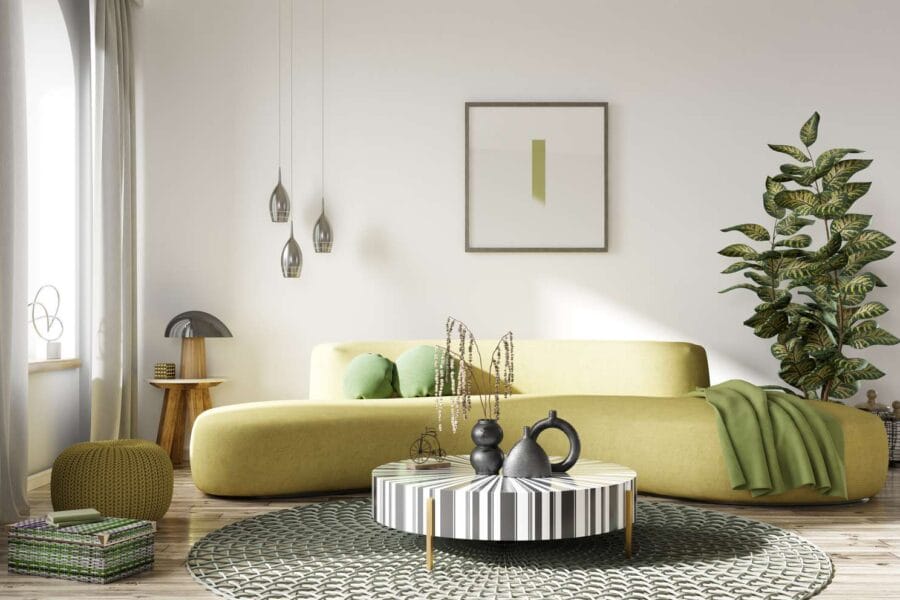In today’s fast-paced world, creating a home that promotes well-being, sustainability, and functionality is more important than ever. This article explores effective strategies for incorporating nature-inspired designs, sustainable materials, bold color palettes, and smart technology into your living space. By addressing these key areas, you can enhance your home’s aesthetic appeal, improve your indoor environment, and embrace modern conveniences—all while contributing positively to the planet.
Whether you’re looking to refresh your current decor or embark on a complete renovation, this guide provides practical tips that cater to both aesthetic and functional needs. Read on to discover how to transform your home into a harmonious and efficient sanctuary.
Table of Contents
Nature Inspired Designs for Serene Spaces
In today’s fast-paced world, where urban life often overwhelms our senses, creating a sanctuary that reflects the tranquility of nature has become essential. Nature-inspired designs not only elevate the aesthetic appeal of a space but also promote a sense of serenity and well-being. By thoughtfully incorporating elements from the natural world, you can transform your living environments into peaceful retreats. Here are some innovative approaches and design ideas to help you create serene spaces that harmonize with nature.
1. Biophilic Design Principles
At the heart of nature-inspired design is biophilia, the innate human affinity for nature. Biophilic design emphasizes an emotional connection to the natural environment by integrating various aspects of nature into indoor spaces. Consider the following components:
- Natural Light: Maximizing natural light not only illuminates your space but also helps to enhance mood and energy. Choose large windows, skylights, or open layouts that allow for as much daylight as possible.
- Indoor Plants: Incorporating plants not only purifies the air but also introduces vibrant colors and textures. Plants like snake plants, pothos, and peace lilies are not just easy to maintain but also contribute to a serene ambiance.
- Natural Materials: Utilize materials such as wood, stone, and bamboo to evoke a natural feel within your home. Sustainable choices like reclaimed wood or environmentally-friendly finishes can enhance the ecological appeal of your design.
 2. Earthy Color Palettes
2. Earthy Color Palettes
The colors that adorn your space can significantly impact your emotional well-being. A palette inspired by nature often includes earth tones—greens, browns, blues, and soft whites—that create a calming environment. Here’s how to effectively implement earthy colors:
- Accent Walls: Choose one wall to showcase a gentle green or muted blue, reminiscent of natural landscapes. This can serve as a backdrop for artwork or plants.
- Textiles: Use natural fabrics in soft, earthy tones for cushions, curtains, and rugs. Fabrics like linen and cotton add texture while maintaining a serene feel.
- Minimalist Decor: Keep decor items minimal to avoid visual clutter. Select pieces made from natural materials that complement your color scheme while enhancing the connection to nature.
3. Natural Patterns and Textures
Integrating patterns and textures that replicate natural elements can enhance the tactile experience of your space. Here are some ideas:
- Organic Shapes: Furniture and decor that mimic organic shapes found in nature, such as curved edges and flowing lines, can create a more relaxed atmosphere.
- Textured Surfaces: Utilize textured wall finishes or fabrics with a tactile quality. For example, stone walls or wooden paneling can introduce depth and warmth.
- Nature-Inspired Art: Artwork depicting natural scenes—landscapes, botanical prints, or abstract representations of nature—can evoke feelings of calmness and connection to the environment.
4. Water Elements
Water is a powerful symbol of tranquility and is often associated with serenity. Incorporating water features into your home can promote a calm, peaceful atmosphere. Consider these options:
- Indoor Water Fountains: A small, flowing water fountain can provide soothing sounds that mimic a gentle stream, enhancing the overall ambiance.
- Aquariums: Aquatic life can be both fascinating and peaceful. A well-maintained aquarium can serve as a dynamic piece of decor while promoting relaxation.
- Reflective Surfaces: Mirrors and glass can reflect light and create the illusion of water, enhancing the spatial feeling of your room while promoting serenity.
5. Outdoor Integration
Bringing the outdoors in is a core tenet of nature-inspired design. This can be achieved through} large sliding doors that open to outdoor patios, or strategically placed windows that frame views of nature. To maximize this integration:
- Outdoor Living Spaces: Enhance your indoor-outdoor flow by creating inviting external areas with comfortable seating, landscaping, and ambient lighting.
- Vertical Gardens: If space is limited, consider vertical gardens or living walls inside your home. They not only save space but also purify the air and make a striking decorative statement.
Incorporating nature-inspired designs into your home fosters a sense of peace and tranquility while also promoting wellness. By selecting appropriate materials, colors, and natural elements, you can create serene spaces that resonate with the soothing essence of the great outdoors.
For more insights on natural design elements, you can explore Architectural Digest’s insights on the topic.
Sustainable Materials for Modern Interiors
As the world increasingly prioritizes environmental consciousness, the demand for sustainable materials in modern interiors is on the rise. Homeowners, designers, and architects alike are on a quest to create spaces that are not only aesthetically pleasing but also environmentally responsible. Transitioning to sustainable materials reflects a commitment to reducing one’s carbon footprint while enhancing the overall vibe of a home. In this section, we will explore various sustainable materials that are transforming modern interiors, their benefits, and how they can be creatively integrated into home design.
1. Bamboo: The Eco-Friendly Superstar
Known for its rapid growth and versatility, bamboo is a standout sustainable material. Unlike traditional timber, bamboo reaches maturity in just three to five years, making it a highly renewable resource. It can be used in numerous applications, from flooring to cabinetry, providing a chic and contemporary aesthetic. Additionally, bamboo is naturally resistant to pests, which means less need for chemical treatments that could harm the environment.
- Durability: Bamboo is remarkably durable, often stronger than hardwood.
- Aesthetic Appeal: Its unique grain patterns add an organic touch to interiors.
- Low Maintenance: Its natural resistance to decay requires fewer maintenance efforts.
By incorporating bamboo into your design, you are not only choosing a stylish option but also making a wise environmental choice.
2. Reclaimed Wood: Adding Character with a Backstory
Reclaimed wood is another excellent sustainable material for modern interiors. Sourced from old barns, factories, or other structures, reclaimed wood brings a sense of history and character to any space. Each piece tells a story, making it a conversation starter while contributing to a more sustainable lifestyle.
- Unique Aesthetics: The weathered look of reclaimed wood adds rustic charm.
- Ecosystem Benefits: Using reclaimed wood reduces the need for new lumber and helps minimize deforestation.
- Versatility: It can be utilized in furniture, flooring, wall paneling, and decorative accents.
Using reclaimed wood allows you to combine style and sustainability, creating spaces full of warmth and unique character.
3. Cork: The Accessible Renewable Resource
Cork is another remarkable sustainable material that is gaining popularity in modern interior design. Harvested from the bark of cork oak trees without harming the tree itself, cork grows back every nine years, making it highly sustainable. Its natural properties include moisture resistance, sound absorption, and thermal insulation.
- Comfort Underfoot: Cork flooring provides a soft, insulating surface, ideal for homes.
- Variety of Finishes: Available in numerous colors and textures, cork can fit seamlessly into any design style.
- Eco-Friendly Production: The process of collecting and processing cork has a low environmental impact.
With its myriad practical benefits and attractive aesthetics, cork is an ideal solution for those looking to create eco-friendly interiors.
4. Recycled Metal: Modern Industrial Charm
Recycled metal offers a chic and modern appeal while being environmentally responsible. Items made from recycled materials, such as aluminum and steel, can significantly reduce energy consumption and raw material extraction. New and unique applications of recycled metal in lighting fixtures, furniture, and décor items are on the rise.
- Strength and Durability: Recycled metal products are often incredibly strong and long-lasting.
- Industrial Aesthetic: Their raw, industrial look adds a modern touch to any space.
- Low Maintenance: Metal items are easy to clean and maintain over time.
Choosing recycled metal is a way to embrace modern trends while making a positive impact on the environment.
5. Natural Fabrics: Soft Touches with a Green Heart
In modern interiors, the choice of fabrics plays a critical role in sustainability. Natural fabrics such as organic cotton, linen, hemp, and wool are increasingly favored due to their eco-friendliness and breathability. Unlike synthetic materials, which are often derived from petroleum-based resources, these fabrics are biodegradable and often produced without harmful pesticides.
- Comfort: Natural fabrics provide a cozy, breathable option for furnishings.
- Sustainable Production: Many natural materials can be sourced locally, further reducing environmental impact.
- Variety in Styles: Available in various colors and patterns, they can complement any design scheme.
Integrating natural fabrics into your interior not only elevates the decor but also supports healthier indoor air quality and a sustainable lifestyle.
By embracing these sustainable materials, modern interiors can evolve into spaces that are beautifully designed and environmentally conscious. As we continue to steer towards an eco-friendly future, the choices we make today will have lasting impacts on our planet and our homes.
For further inspiration on sustainable design practices, you may refer to Green Building Advisor, which provides extensive resources on sustainable materials and building practices.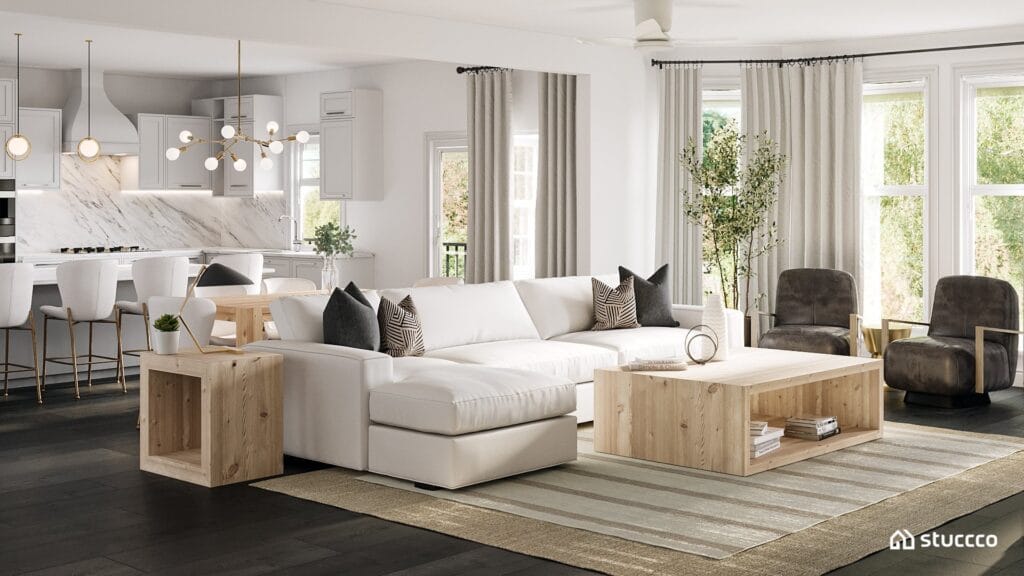
Bold Color Palettes to Enhance Ambiance
In the world of interior design, color is one of the most powerful tools at our disposal. It has the ability to affect our mood, influence our emotions, and shape our overall experience within a space. Bold color palettes can transform a bland room into a lively sanctuary, allowing individuals to express their personality and create a distinct ambiance. This section explores how to effectively use bold colors to enhance your home environment while maintaining a cohesive design scheme.
The Psychology of Color in Design
Understanding the psychology of color is crucial when choosing bold palettes for your interior. Each color elicits different emotional responses. For instance:
- Red – Often associated with energy and passion, it can stimulate excitement and encourage conversation.
- Blue – Known for its calming effects, shades of blue can create a serene atmosphere, perfect for bedrooms and relaxation areas.
- Yellow – This vibrant hue evokes feelings of happiness and positivity, ideal for kitchens and creative spaces.
- Green – Symbolizing nature and renewal, green can bring a refreshing vibe into your living areas.
By leveraging these associations, homeowners can craft spaces that not only look aesthetically pleasing but also feel emotionally resonant.
Creating a Cohesive Color Scheme
To avoid overwhelming a space with bold colors, it is essential to create a balanced and cohesive color scheme. Here are some strategies:
- Accent Walls: Choose one wall to splash with an intense color while keeping the other walls more neutral. This draws attention and creates depth without overpowering the room.
- Color Blocking: This technique involves pairing contrasting colors in distinct sections of a room, adding dimensionality and flair to the design. For instance, a bold orange sofa paired with deep navy walls can create a striking visual contrast.
- Accent Decor: Use bold colors for smaller decor items like cushions, throws, or artwork. This allows for flexibility; you can easily swap pieces out for seasonal freshness or stylistic changes.
By thoughtfully integrating bold colors within your design, you can draw attention to specific areas and establish a harmonious flow throughout the space.
Incorporating Patterns and Textures
Bold colors are even more dynamic when complemented with patterns and textures. Mixing these elements can elevate the design, providing visual interest and depth:
- Geometric Patterns: Use rugs, curtains, or wall art featuring geometric designs in bold colors to create a modern and chic look.
- Textured Fabrics: Incorporate textiles like velvet or linen in your bold color palette to add richness and dimension to your space.
- Artwork: Consider investing in oversized artworks or statement pieces that reflect your chosen palette, bringing the entire room together.
By combining bold colors with varied textures and patterns, you can create a visually engaging space that captivates the eye and resonates with the spirit of those who live in it.
 Showcasing Bold Color in Different Rooms
Showcasing Bold Color in Different Rooms
Each room in your home can benefit from the incorporation of bold colors, but the approach may vary by space:
- Living Room: This central space can showcase vibrant shades like teal or mustard, paired with neutral furnishings to maintain balance.
- Kitchen: Cheerful colors such as bright yellow or orange can foster positivity and energy, making meal prep more enjoyable.
- Bedroom: Utilize deeper hues like navy or burgundy to create a cozy, intimate atmosphere conducive to relaxation and rest.
- Office/Creative Space: Colors like green or blue foster productivity and focus, making them optimal choices for work environments.
Choose colors thoughtfully based on the function of each room, ensuring they align with the activities performed within those spaces.
Embracing Seasonal Changes
Bold color palettes also allow for adaptability with the changing seasons. Updating your decor can refresh your home while reflecting the vibrancy of the current season. Consider seasonal themes—such as earthy tones in fall or bright pastels in spring—to breathe new life into your surroundings. This flexibility keeps your space feeling fresh and inviting year-round.
Whether through larger architectural choices or smaller decorative accents, embracing bold colors can significantly enhance the ambiance of your home. By understanding color psychology, creating cohesive schemes, incorporating patterns, and adapting to seasonal shifts, you can fully leverage the transformative power of color in your interior spaces.
To explore bold color trends further, visit Sherwin-Williams for expert insights and inspiration on paint and color choices.
Smart Technology Integration for a Connected Home
In today’s rapidly evolving world, the concept of a connected home is no longer just a futuristic dream; it’s a reality that is transforming the way we live. With the integration of smart technology, homeowners can enhance their living environments, improve security, increase energy efficiency, and enjoy unprecedented convenience. This section explores how smart technology can be effectively integrated into modern homes to create a seamlessly connected living experience.
Understanding Smart Home Technology
At its core, smart home technology refers to a system of devices and appliances that connect to the internet, allowing users to control them remotely via smartphones, tablets, or smart speakers. This connectivity enables various features such as automation, monitoring, and real-time notifications. Homeowners can choose from a plethora of devices, including:
- Smart Thermostats – These devices learn your heating and cooling preferences, optimizing energy use and saving money on utility bills.
- Smart Security Systems – From doorbell cameras to motion detectors, smart security systems provide peace of mind by allowing homeowners to monitor their property remotely.
- Smart Lighting – Intelligent lighting solutions enable users to adjust brightness, color, and schedules through their smartphones, improving comfort and energy efficiency.
- Smart Appliances – These include refrigerators, ovens, and washing machines that can be controlled digitally, making everyday tasks easier and more efficient.
Key Benefits of Smart Home Integration
Integrating smart technology into your home provides numerous advantages:
- Enhanced Convenience – Smart home systems allow you to control multiple devices from a single app or voice command, streamlining daily activities.
- Increased Security – With real-time alerts and remote monitoring, you can keep a vigilant eye on your home, deterring potential intruders.
- Energy Efficiency – Smart devices can optimize energy use based on your habits, reducing waste and lowering utility costs.
- Home Automation – Create customized routines that automate tasks such as turning on lights or adjusting the thermostat at specific times.
Pioneering Smart Technology Innovations
The landscape of smart home technology is continuously evolving, with new innovations emerging regularly. Here are a few of the latest advancements:
- AI-driven Personal Assistants – Devices like Amazon Alexa and Google Assistant are becoming more intelligent, enabling more sophisticated voice commands and personalized experiences.
- Smart Sensors – These devices can monitor various conditions, including air quality, water leaks, and temperature changes, enhancing safety and improving home management.
- Integrated Home Hubs – Central hubs can connect various devices across brands and functionalities, ensuring compatibility and simplifying user experience.
Tips for Successful Smart Home Integration
To maximize the benefits of smart technology, consider the following tips:
- Start Small – Begin with a few devices to understand your preferences and gradually expand your smart home ecosystem.
- Ensure Compatibility – Choose devices that are compatible with your existing smart home products to prevent issues later on.
- Stay Informed – Keep up with the latest developments in smart technology to take advantage of new features and upgrades.
- Focus on Security – Regularly update device firmware and use strong passwords to protect your connected home from security breaches.
As you embrace the convenience and security of a smart home, remember that the integration should enhance your lifestyle without overwhelming it. By selecting the right technology and following these tips, you can create a home that not only meets your daily needs but also adapts to your evolving lifestyle.
To learn more about the best smart home devices currently available, consider exploring reputable sources such as CNET’s roundup of smart home technology, which provides reviews and insights on leading products and trends in this dynamic market. Incorporating natural elements and sustainable materials into your home design can significantly enhance both aesthetics and well-being. Outdoor living spaces, vertical gardens, bamboo, reclaimed wood, cork, recycled metal, and natural fabrics are key sustainable materials that not only promote environmental responsibility but also elevate interior ambiance. Understanding color psychology and effectively using bold palettes can further enrich your surroundings while enabling personalization.
To create a smart, connected home, consider integrating smart technology like thermostats, security systems, and appliances for greater convenience, security, and energy efficiency. Starting with a few devices, ensuring compatibility, and keeping your technology secure can help you build a cohesive smart home that effortlessly adapts to your lifestyle. For more ideas and insights, explore trusted resources in sustainable design and smart technology.


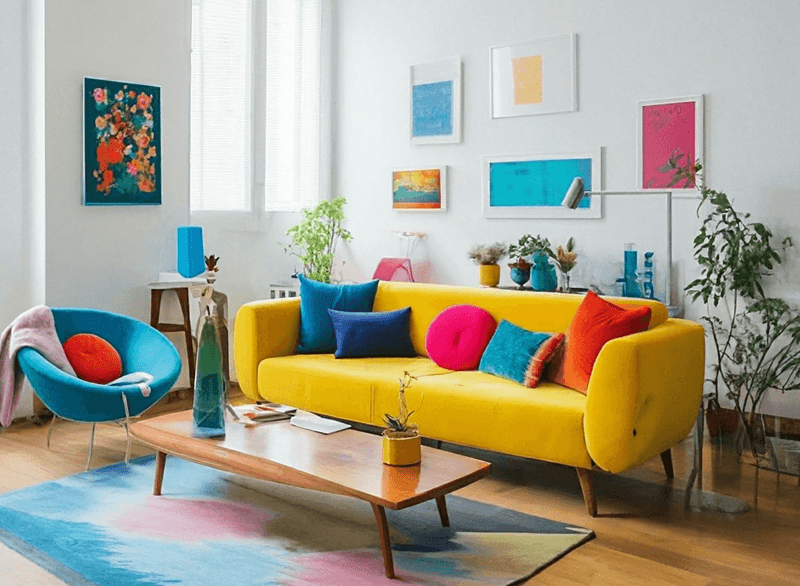
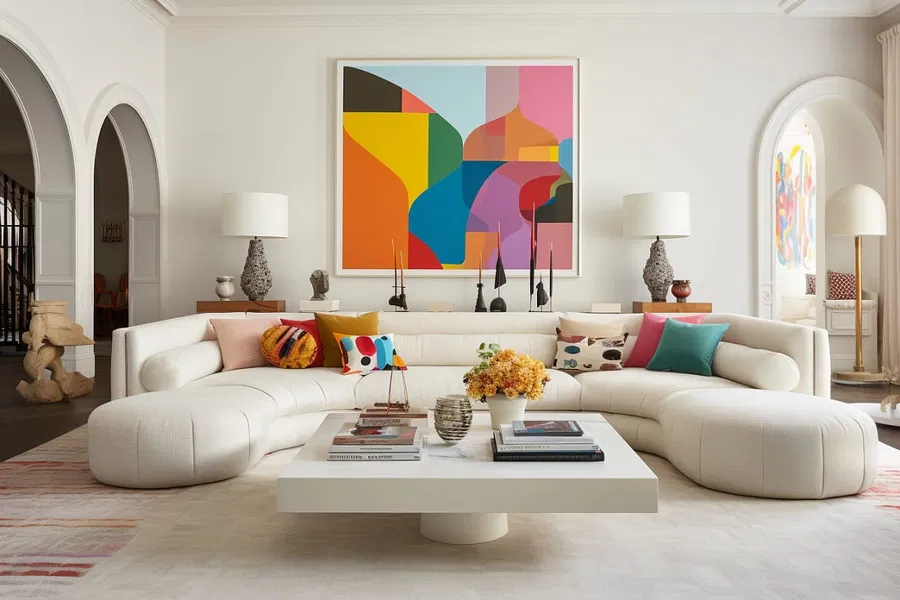 2. Earthy Color Palettes
2. Earthy Color Palettes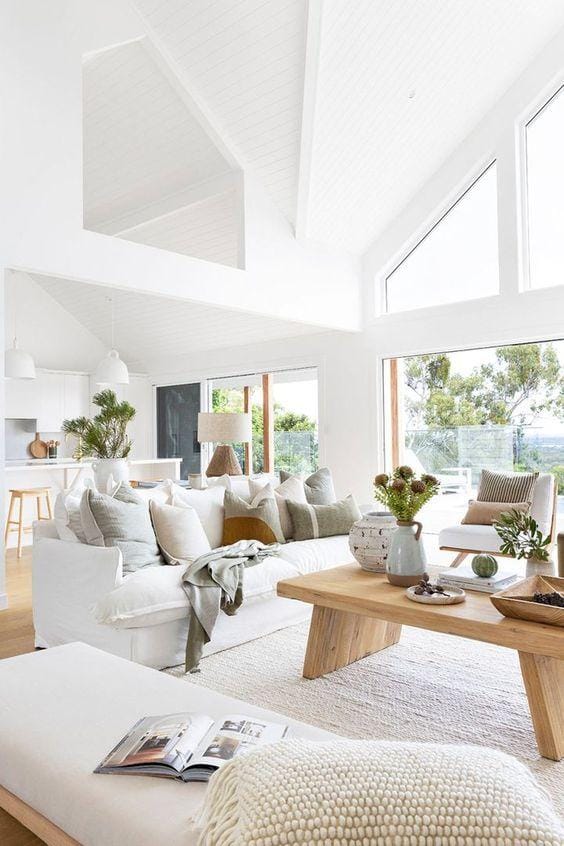 Showcasing Bold Color in Different Rooms
Showcasing Bold Color in Different Rooms
